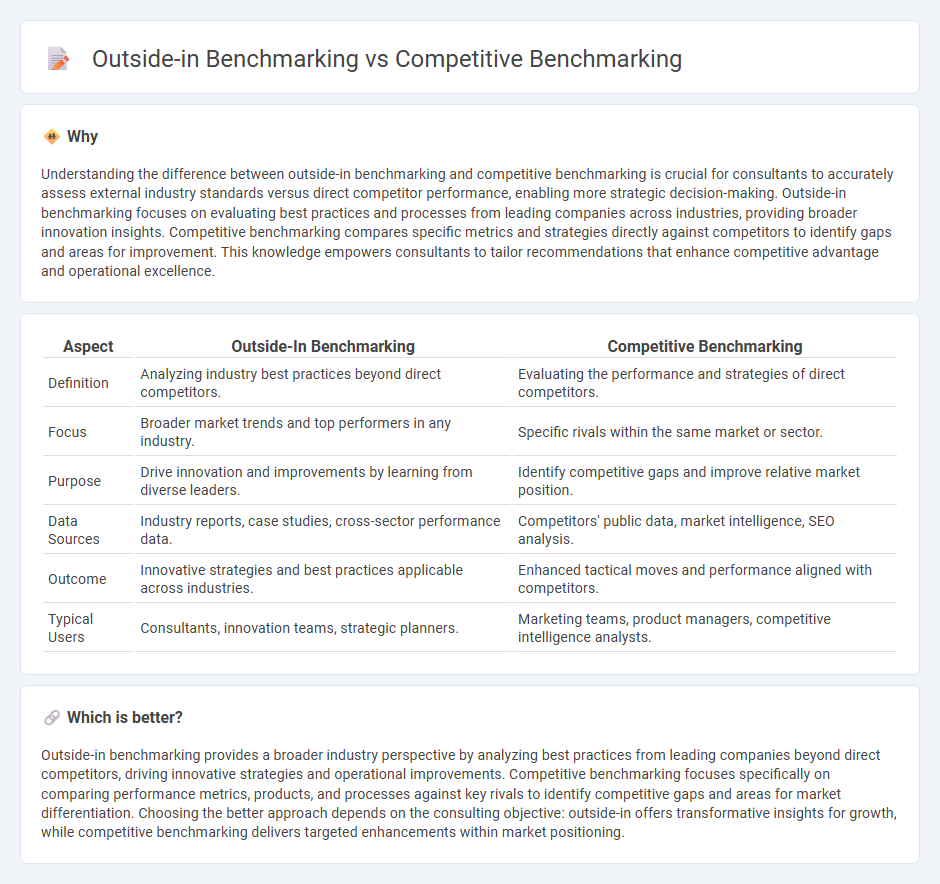
Outside-in benchmarking analyzes industry leaders' practices to uncover innovative strategies and improve organizational performance. Competitive benchmarking focuses on comparing specific metrics and processes directly against key competitors to identify strengths and weaknesses. Explore further to understand which benchmarking approach best suits your business goals.
Why it is important
Understanding the difference between outside-in benchmarking and competitive benchmarking is crucial for consultants to accurately assess external industry standards versus direct competitor performance, enabling more strategic decision-making. Outside-in benchmarking focuses on evaluating best practices and processes from leading companies across industries, providing broader innovation insights. Competitive benchmarking compares specific metrics and strategies directly against competitors to identify gaps and areas for improvement. This knowledge empowers consultants to tailor recommendations that enhance competitive advantage and operational excellence.
Comparison Table
| Aspect | Outside-In Benchmarking | Competitive Benchmarking |
|---|---|---|
| Definition | Analyzing industry best practices beyond direct competitors. | Evaluating the performance and strategies of direct competitors. |
| Focus | Broader market trends and top performers in any industry. | Specific rivals within the same market or sector. |
| Purpose | Drive innovation and improvements by learning from diverse leaders. | Identify competitive gaps and improve relative market position. |
| Data Sources | Industry reports, case studies, cross-sector performance data. | Competitors' public data, market intelligence, SEO analysis. |
| Outcome | Innovative strategies and best practices applicable across industries. | Enhanced tactical moves and performance aligned with competitors. |
| Typical Users | Consultants, innovation teams, strategic planners. | Marketing teams, product managers, competitive intelligence analysts. |
Which is better?
Outside-in benchmarking provides a broader industry perspective by analyzing best practices from leading companies beyond direct competitors, driving innovative strategies and operational improvements. Competitive benchmarking focuses specifically on comparing performance metrics, products, and processes against key rivals to identify competitive gaps and areas for market differentiation. Choosing the better approach depends on the consulting objective: outside-in offers transformative insights for growth, while competitive benchmarking delivers targeted enhancements within market positioning.
Connection
Outside-in benchmarking enhances competitive benchmarking by incorporating external customer perspectives and market trends into the analysis. Competitive benchmarking focuses on comparing specific competitors' processes and performance metrics, while outside-in benchmarking broadens the scope by evaluating customer needs and experiences. Together, they provide a comprehensive view that aligns internal capabilities with external market demands for strategic consulting decisions.
Key Terms
Competitive Benchmarking:
Competitive benchmarking involves analyzing direct competitors' products, services, and processes to identify strengths and weaknesses that impact market position. This approach emphasizes assessing key performance indicators (KPIs) such as market share, operational efficiency, and customer satisfaction to gain actionable insights. Explore how competitive benchmarking can enhance your strategic decisions and drive business growth.
Direct Competitor Analysis
Competitive benchmarking involves comparing a company's products, services, and processes directly against those of its immediate rivals to identify strengths and weaknesses in a similar market context. Outside-in benchmarking extends beyond direct competitors by analyzing industry leaders and companies from different sectors to gain broader insights and innovative strategies. Discover more about how direct competitor analysis sharpens business strategy and drives market positioning.
Performance Metrics
Competitive benchmarking compares performance metrics such as revenue growth, market share, and customer satisfaction against direct industry rivals to identify strengths and weaknesses. Outside-in benchmarking expands the scope by analyzing best practices and key performance indicators from leading companies across diverse industries for innovative performance improvements. Explore our detailed analysis to understand how each approach can drive strategic decision-making and operational excellence.
Source and External Links
Guide to Competitive Benchmarking: Overview, Steps & FAQs - Competitive benchmarking is the process of comparing your business, product, or service to your competitors to identify strengths, weaknesses, and opportunities for improvement by analyzing metrics like market share, revenue growth, and customer satisfaction.
What Is Competitive Benchmarking? | Indeed.com - Competitive benchmarking involves assessing your company's performance by comparing internal metrics with those of top competitors to understand which strategies best contribute to achieving business goals and to identify improvement areas.
Competitive Benchmarking in 2025: Best Practice Guide - Competitive benchmarking promotes continuous improvement by regularly measuring your performance against direct competitors, enabling data-driven decisions that enhance competitiveness, market share, and customer loyalty.
 dowidth.com
dowidth.com